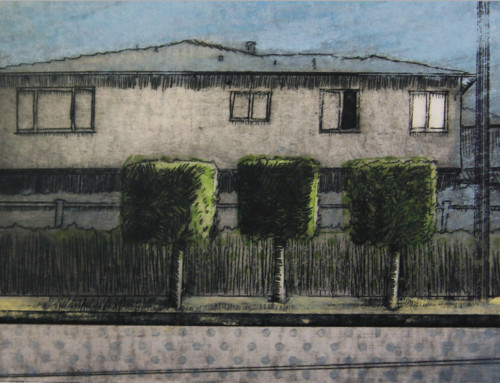If you are reading on a mobile device, click here to open the google slide presentation.
A pdf of the Intaglio – Drypoint: Overview and Getting Started text can be downloaded here.
OVERVIEW
Intaglio is a printing process where a printing matrix is incised with marks, ink is forced into those marks and then the smooth surface of the matrix is wiped clean. The image is printed by placing a piece of dampened paper over the inked matrix and running the two through an etching press, forcing the paper into the depressions, and transferring the ink from the matrix to the paper. Traditionally intaglio plates are created on copper or zinc as they are soft enough to be manipulated but hard enough to withstand large edition sizes. With copper or zinc plates, other intaglio processes can be combined with drypoint. Plexiglass, PETG, Tetra Pak, and gessoed mat board are some of the drypoint matrices used by contemporary drypoint artists.
Drypoint is a non-acid intaglio method in which the plate surface is roughened, typically with a sharp needle tool. As the tool digs into the plate surface, burrs are raised. The burrs, more so than the incised lines, hold most of the printing ink that is transferred to the paper. The drypoint mark prints soft and velvety, as each time the plate is wiped the burrs catch the ink slightly different than how they did the prior impression. The matrix is extremely fragile and breaks down quickly, as the raised burr is pushed down from the pressure of printing.
HISTORY
Drypoint is the most direct method for producing intaglio prints. Unlike the indirect process of etching, where a plate is ground, drawn through and etched, drypoint marks are instantly able to hold ink and print. Drypoint is much easier for new printmakers to learn than the non-acid techniques of engraving or mezzotint, which take practice and patience to master, as the drypoint scribe is similar to a pencil.
The south German artist, the Housebook Master (1450-1500), is credited with inventing the technique, as he solely used drypoint for all of his prints. 16th century artists applied touches of drypoint to their etched plates to produce stronger or softer tones. Rembrandt (1606-1669) is the next notable artist to widely explore the process, though typically in combination with etching and engraving. Rembrandt was a prolific, experimental printmaker who often took plates through multiple state changes and produced limited runs. Historically, artists interested in large editions for commercial viability have not produced drypoints because of the short printing runs and inconsistency of editions. Intaglio underwent a revival in the 19th and 20th century, as mass production boomed with the advent of photography and commercial lithography. Fine artists turned towards expressive medias, such as drypoint intaglio prints produced in limited editions. Contemporary artists have also embraced drypoint, as many enjoy the direct nature and unique characteristic of drypoint imagery.
CITATIONS:
Polymetaal.nl, A technical dictionary of printmaking: Drypoint, Etching, Steelfacing
Art History Project: Drypoint – Soft marks from scarring metal

